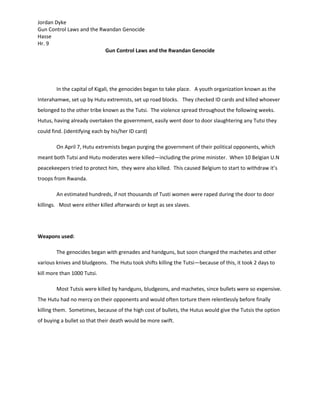
Rwanda
- 1. Jordan Dyke Gun Control Laws and the Rwandan Genocide Hasse Hr. 9 Gun Control Laws and the Rwandan Genocide In the capital of Kigali, the genocides began to take place. A youth organization known as the Interahamwe, set up by Hutu extremists, set up road blocks. They checked ID cards and killed whoever belonged to the other tribe known as the Tutsi. The violence spread throughout the following weeks. Hutus, having already overtaken the government, easily went door to door slaughtering any Tutsi they could find. (identifying each by his/her ID card) On April 7, Hutu extremists began purging the government of their political opponents, which meant both Tutsi and Hutu moderates were killed—including the prime minister. When 10 Belgian U.N peacekeepers tried to protect him, they were also killed. This caused Belgium to start to withdraw it’s troops from Rwanda. An estimated hundreds, if not thousands of Tusti women were raped during the door to door killings. Most were either killed afterwards or kept as sex slaves. Weapons used: The genocides began with grenades and handguns, but soon changed the machetes and other various knives and bludgeons. The Hutu took shifts killing the Tutsi—because of this, it took 2 days to kill more than 1000 Tutsi. Most Tutsis were killed by handguns, bludgeons, and machetes, since bullets were so expensive. The Hutu had no mercy on their opponents and would often torture them relentlessly before finally killing them. Sometimes, because of the high cost of bullets, the Hutus would give the Tutsis the option of buying a bullet so that their death would be more swift.
- 2. Jordan Dyke Gun Control Laws and the Rwandan Genocide Hasse Hr. 9 State/Country Law Statistics for Rwanda: 1. Population: 10,942,950 (according to WorldBank) 2. Total # of guns: Government: Defense Forces: 9,880 Police: 12,686 Civilians: Privately Owned: 58,000 Rate of civilian possession: 0.6 firearms per 100 people # Of privately owned firearms—World rate: 151st out of 178 countries 3. # of Homicides by any means total: 2008: 1,708 By means per 100,000 populations is: 2008: 2.4 2007: 4.5 2006: 4.8 2003: 4.2 2002: 20.00 1999: 45.08 4. Firearm Law: Guiding gun control legislation in Rwanda is the Law No 13/2000 of 14/06/2000 modifying the decree, the law No 12/79 of 7th May, 1979 concerning Firearms and their ammunitions, and Law No. 33/2009 of 11/2009 on the Arms System. The right to own private firearms is NOT guaranteed by law. Civilians are not allowed to posses weapons of war and rifle sticks, folding rifles, rifles with a barrel or butt that can be disassembled into separate parts, firearms with silencers, firearms with toxic effects, and any others that would be considered secretive. In Rwanda, private possession of fully automatic weapons is permitted under a license. In Rwanda, private possession of semi automatic weapons is permitted under a license. In Rwanda, private possession of fully automatic weapons is permitted under a license. In Rwanda, private possession of handguns is permitted under a license Carrying guns in public: In Rwanda, carrying a firearm in plain view in a public place is allowed, but it is subject to a valid permit. In Rwanda, concealing a firearm in plain view in a public place is allowed, but it is subject to a valid permit
- 3. Jordan Dyke Gun Control Laws and the Rwandan Genocide Hasse Hr. 9 What Should Be Done to Prevent This? In the aftermath of WWII, the Holocaust, etc, the United Nations adopted a resolution on December 9, 1948, which stated that “The contracting parties confirm that genocide, whether committed in time of peace or war, is a crime under international law which they undertake to prevent and punish.” Since most Hutu moderates were killed, the U.N viewed this as a civil war instead of genocide so they did not step in. Why gun control laws could have prevented the genocide: (Kopel) Why gun control could NOT have prevented the genocide: Stricter gun control promoted the Nazi genocide against 6,0000,0000 Jews and 7,000,000 Gentiles, in which 1.5 million Jewish children were murdered. The Nazis inherited a gun control law from the Weimar Republic, which enacted gun control to curb political violence. (Rice &Simkin, 19) Strict Gun control promoted the 20th century genocides, such as Rwanda, because gun control laws are a step by step euphemism for disarming civilians—which directly promotes genocide. In just 103 days, 800,000 Rwandans were murdered in 1994 because of the laws of November 23, 19964 and May 1979. (Rice &Simkin, 19) General civilian ownership of firearms is the only way to prevent mass genocides. (Rice &Simkin, 19)
- 4. Jordan Dyke Gun Control Laws and the Rwandan Genocide Hasse Hr. 9 Citations GunPolicy.org. (19, July 2012). Gunpolicy.org. Retrieved from http://www.gunpolicy.org/firearms/region/rwanda About.com. (n.d.).About.com. Retrieved from http://history1900s.about.com/od/rwandangenocide/a/Rwanda-Genocide.htm WorldBank.org. (n.d.).The world bank. Retrieved from http://www.worldbank.org/ Rice, A. M., &Simkin, J. E. (19, Febuary 2000). Gun control and genocide. Retrieved from http://gunowners.org/op0002.htm Kopel, D. (n.d.). Gun bans & genocide: The disarming facts. Retrieved from http://www.davekopel.com/2A/Foreign/gun-bans-and-genocide.htm